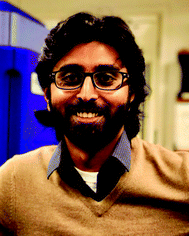Horizons Community Board Collection: Biosensors
Zhiyuan
Liu
*a,
Gift
Mehlana
 *b and
Arun Richard
Chandrasekaran
*b and
Arun Richard
Chandrasekaran
 *c
*c
aShenzhen Institutes of Advanced Technology, Chinese Academy of Sciences, China. E-mail: zy.liu1@siat.ac.cn
bMidlands State University, Zimbabwe. E-mail: gift.mehlana66@gmail.com
cThe RNA Institute, University at Albany, SUNY, USA. E-mail: arun@albany.edu
Materials Horizons and Nanoscale Horizons set up their Community Boards several years ago, aiming to support early career researchers so that they can share their experiences and ideas on scientific publishing. As future leaders in their respective fields, the Community Boards also provide a channel for members to build relationships across their research community and develop their own editorial skills.
This collection continues a series of post-publication online article collections, led by our Community Board members across both Materials Horizons and Nanoscale Horizons.
Working together and sharing their unique areas of expertise, our Community Board members have recommended several key topics where significant, rapid progress has been made in the last 2 years. They have selected top articles published in the Horizons journals to showcase the most important advances in each topic area.
Biosensing
The development of sensing technologies has been one of the prime focuses of recent research. In this area, scientists have developed different types of materials for use in biosensing, analyzed different biological targets and specimens, and combined nanoscale developments with the macroscopic world for real-life applications. In this collection, we have compiled a list of articles that discuss these developments in the area of biosensing.Many new developments in biosensing begin with the detection or identification of disease biomarkers and biological targets, such as nucleic acids (microRNAs, gene fragments) and proteins (tumor-related proteins, for example). Over the years, scientists have utilized nanomaterials in biosensing for their favorable optical properties and functionality. These materials range from metal oxide nanoparticles (DOI: 10.1039/C7MH00804J) to molecular materials such as DNA (DOI: 10.1039/C8MH01151F) and liposomes (DOI: 10.1039/C9NH00097F). Such sensors have been deployed for use in cancer diagnostics (DOI: 10.1039/D0NH00258E), in vivo temperature mapping (DOI: 10.1039/C9NH00693A) and cardiovascular diseases (DOI: 10.1039/C8MH01293H).
Towards more practical uses of biosensors, scientists have developed soft and stretchable bio-sensing elements. These are crucial for human body-integrated, long-term, real-time monitoring of biological information including bio-electrical, bio-mechanical and bio-chemical signals. Since human tissues, like skin and other organs, are intrinsically soft and stretchable, devices that integrate with these tissues are required to be soft and stretchable to achieve mechanical matching. Materials like hydrogels play an important role due to their softness and multi-functionality. However, new functions of hydrogels should be further developed for bio-sensing, e.g. anti-drying, self-healing (DOI: 10.1039/C8MH01160E), tissue adhesion (DOI: 10.1039/D0MH00361A) and triggerable properties (DOI: 10.1039/D0MH00862A). These new properties make hydrogel-based soft electronic devices more diverse and adaptable for biosensing applications. Other than hydrogels, modified elastomers with higher strength are also important, especially for bio-mechanical sensors, such as polyionic elastomers (DOI: 10.1039/C8MH01157E) and others structured for high-sensitivity pressure sensors (DOI: 10.1039/C9NH00671K). For the future, soft biochemical sensing is vital for healthcare monitoring; however, it is less reported than other biosensors due to the challenges of specificity, selectivity and stability. A novel noninvasive glucose sensing strategy has been reported (DOI: 10.1039/D0NH00098A), but more bio-molecular sensing methods are still waiting to be investigated.
One other area of biosensing is bioelectronics, a developing field at the interface of the life and physical sciences which connects biological systems with conventional electronics such as semiconductors in a bid to create new medical therapies. One of the key underlying challenges in bioelectronics is to transduce between the predominantly ionic signals of biology and the electronic signals of semiconductors. To this end, various strategies have been developed to address this challenge. The proton conducting biopolymer melanin and a p-type organic electrochemical transistor (OECT) have been developed as a solid-state transducing interface capable of computing at the biology–electronic interface (DOI: 10.1039/C7MH00831G). Molecular antennas have also been introduced on organic thin-film transistors to produce a bioelectric sensor interface that allows for direct interactions between the semiconductors and the target analytes in solution (DOI: 10.1039/C7MH00887B). The majority of studies have focused on the use of p-type OECT to produce bioelectric sensors; recent studies show that the use of n-type OECT could pave the way for the development of next-generation biosensors and bioelectronic hybrids (DOI: 10.1039/D0MH00548G). This collection of articles will provide some insight into recent developments in biosensing and the adaptability of ongoing lab-based research for practical applications.
Read the collection here.
| This journal is © The Royal Society of Chemistry 2020 |



